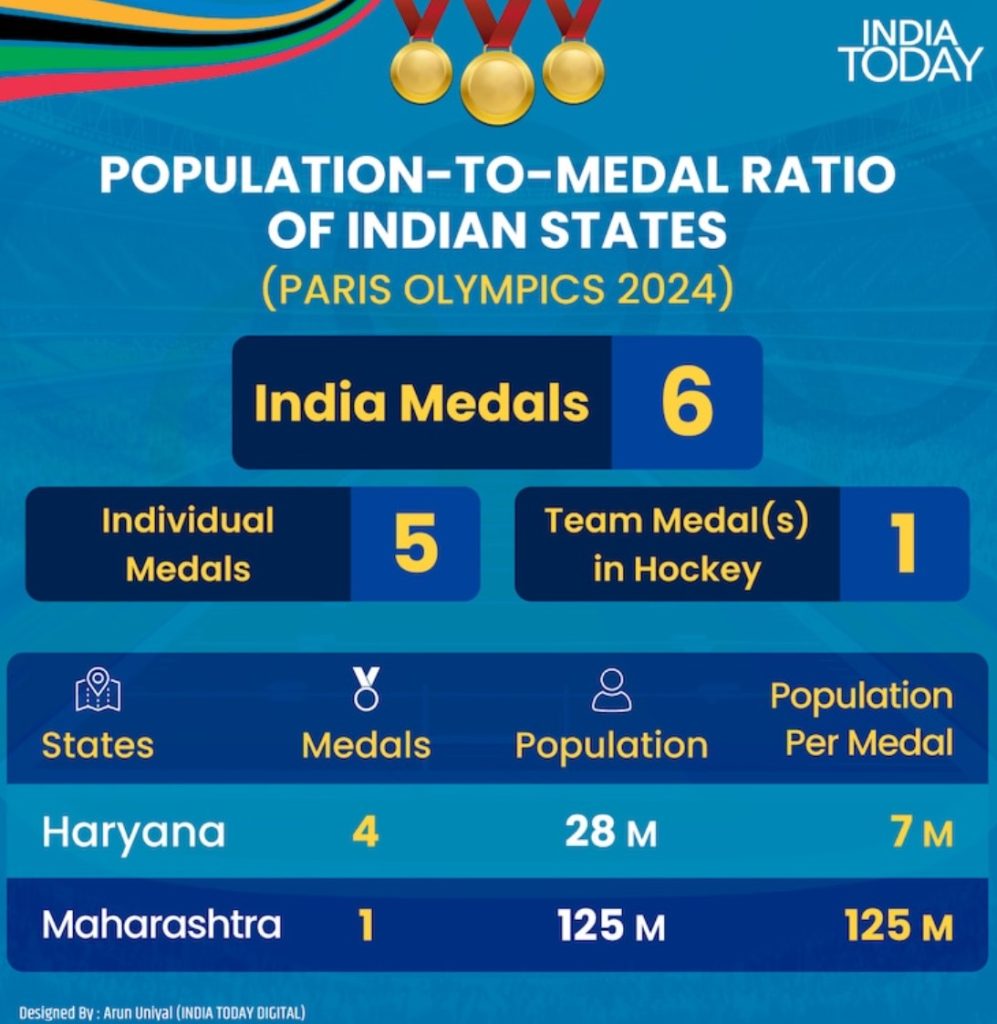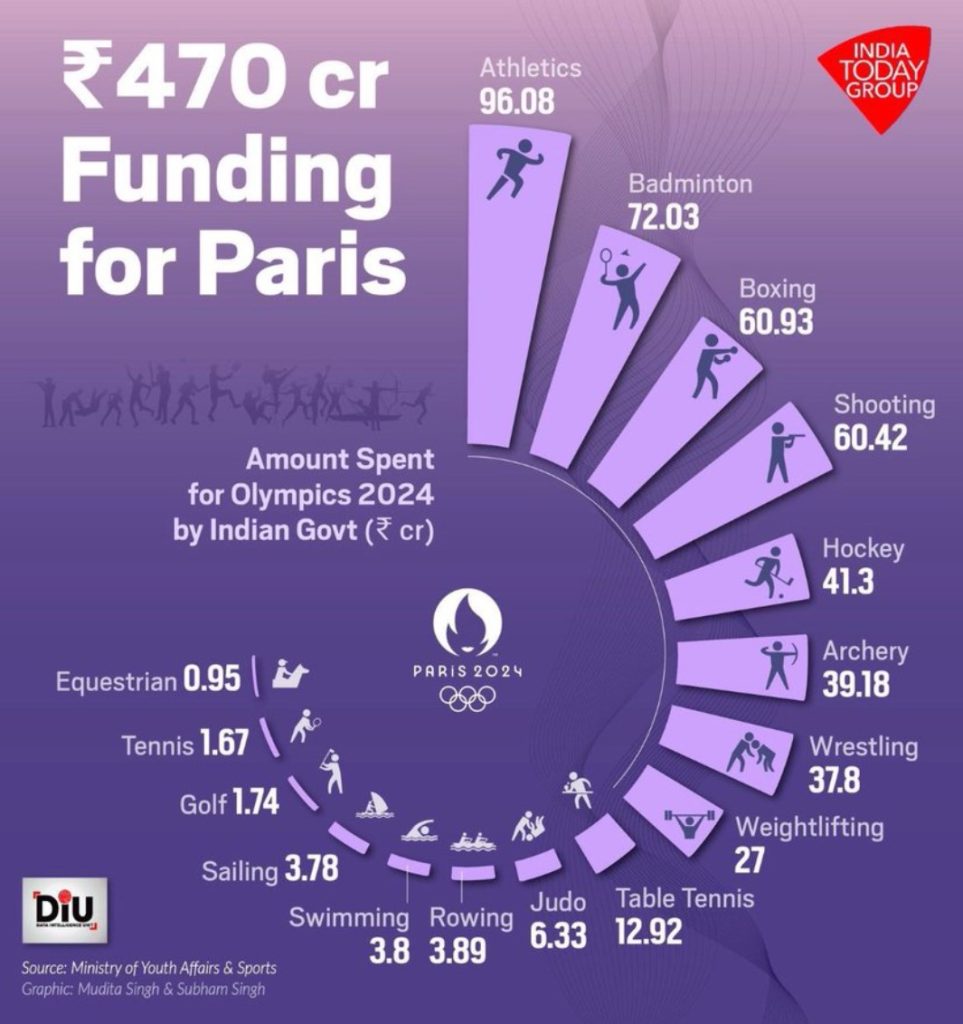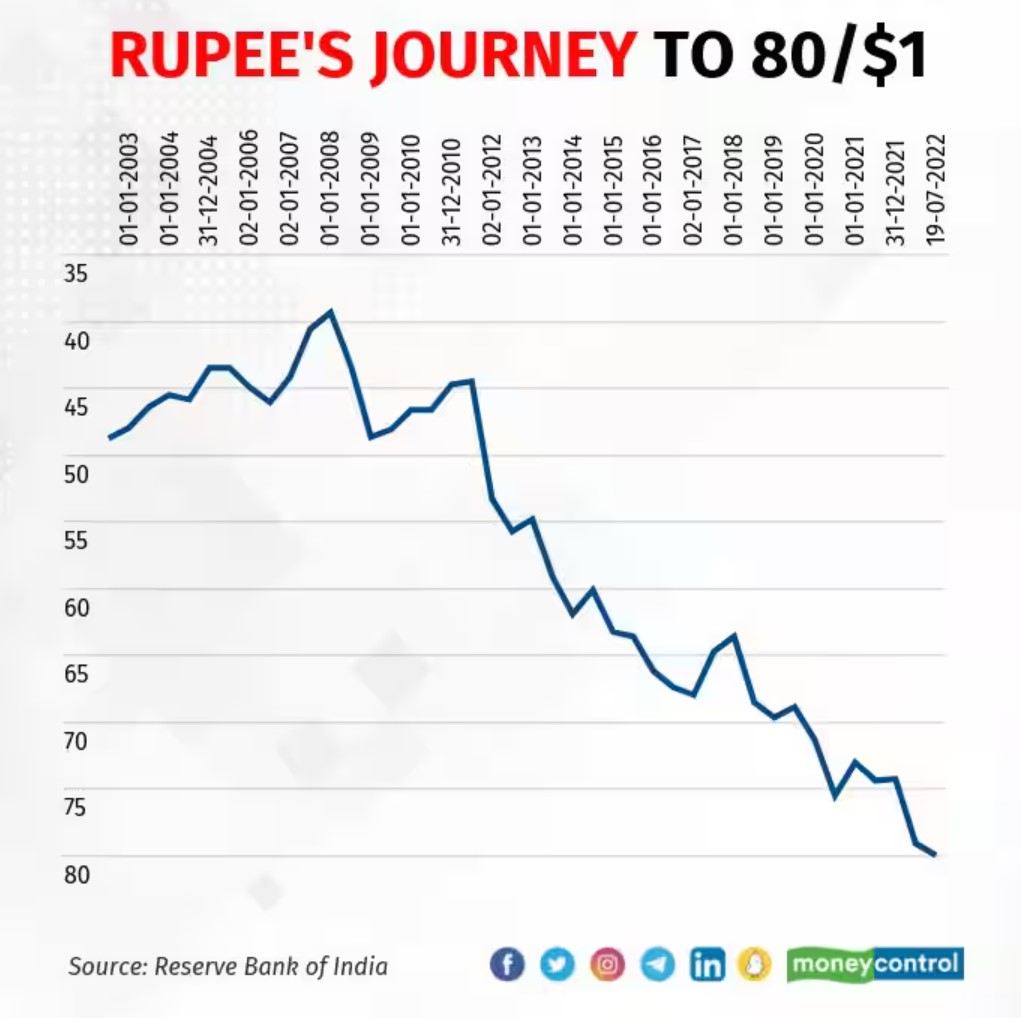CONTENTS
- Broadening the Sports Base for Success in Olympics
- Rupee’s Fall Against Dollar is a Wake-Up Call for India
Broadening the Sports Base for Success in Olympics
Context:
India’s return of six medals from the recently concluded Paris Olympics can be described as underwhelming. The nation earned one silver and five bronze medals, a decline from the seven medals, including a gold and two silvers, achieved at Tokyo 2020.
Relevance:
GS2-
- Government Policies & Interventions
- Sports and Affairs
- Health
Mains Question:
Examine India’s performance in the recently concluded Paris Olympics. Suggest a way forward strategy to further enhance India’s performance in international sporting events. (10 Marks, 150 Words).

Results Fell Short of Expectations:
- Despite efforts to diversify its sporting prowess, strong support from the government and major corporations, and an ambition to achieve a double-digit medal count, the results fell short of expectations.
- Nevertheless, new stars emerged, with shooters Manu Bhaker, Sarabjot Singh, and Swapnil Kusale, along with wrestler Aman Sehrawat, becoming household names.
- The men’s hockey team also secured a podium finish for the second consecutive time, and Neeraj Chopra added a silver to his historic javelin gold from Tokyo.
- However, the heavy reliance on a select few athletes, the lack of presence in sports like swimming and gymnastics, and the disqualification of wrestler Vinesh Phogat for exceeding the weight limit cast a shadow over the achievements.
Reasons Behind India’s struggles in Olympics:
Talent Identification:
- In India, the process of identifying talent often happens on an ad-hoc basis, with limited reach and effectiveness.
- Systemic issues in scouting and recognizing young athletes, especially in remote areas, hinder the discovery of potential talent.
Infrastructure and Resources:
- Many parts of India lack the necessary infrastructure and resources to properly train athletes. Limited access to training facilities, expert coaching, and financial support can impede the development of promising athletes.
- Despite the growing wealth in India, sponsorship and investment in sports other than cricket remain inadequate.

Cricket’s Dominance:
- Cricket’s overwhelming popularity in India has skewed the sports landscape, with 87% of sports funding allocated to cricket and only 13% to all other sports.
- This imbalance has stunted the growth of Olympic sports. The lack of a robust sports culture and media promotion outside of cricket further exacerbates this issue.
Insufficient Sports Policies:
Historically, India’s sports policies have been fragmented and underfunded. Although there have been initiatives like the Target Olympic Podium Scheme (TOPS) to improve sports infrastructure and support athletes, these efforts are relatively new and have yet to produce significant results.
Long-term Development:
- India’s sports programs often prioritize short-term successes over long-term athlete development. Producing world-class athletes requires sustained investment and planning over many years.
- Successful Olympic nations have long-term development plans that include early talent scouting, comprehensive training, and continuous support throughout an athlete’s career.
Corruption and Politics in Sports Administration:
- Sports administration in India is frequently dominated by politicians and bureaucrats, leading to the politicization of sports governance.
- Corruption and bureaucratic hurdles often obstruct the development of athletes, with their needs frequently taking a backseat.
- Indian sports organizations, particularly governing bodies, have not adapted to the challenges of a professional and commercialized sector, relying on volunteers rather than skilled professionals.
- The recent conflicts within the Wrestling Federation highlight the broader issues within Indian sports administration.
Absence of a Sports Culture:
- In India, societal preference leans heavily toward education over sports. Families often prioritize careers in fields like medicine or accounting, viewing sports as a less viable option for financial security.
- India’s complex social structure, with strong ties to caste and regional identity, further impedes the development of a unified sports culture.
- Many communities discourage pursuing sports at an elite level, instead emphasizing traditional roles.
What Can India Do to Improve Its Olympic Performance?
Grassroots Development:
There needs to be a stronger focus on developing sports at the grassroots level. Identifying and nurturing talent from a young age across various sports disciplines can help build a solid foundation.
Investment in Infrastructure:
Building world-class training facilities and providing athletes with access to top-tier coaching and support systems, including psychological support, nutrition, and injury management, is crucial.
Empowering Athletes:
Athletes are the primary stakeholders in sports, and involving them in decision-making can bring much-needed accountability and transparency to sports organizations.
Collegiate Sports System:
- India should develop a collegiate sports system similar to the National Collegiate Athletics Association (NCAA) in the United States.
- The NCAA has produced a remarkable number of Olympic champions, not just for the US but for countries worldwide.
Cultural Shift:
Changing societal attitudes towards sports is essential. Encouraging families to support children in pursuing sports careers and integrating sports into the education system can help.
Increased Government Support:
The government should provide more consistent and substantial funding for Olympic sports, including direct support to athletes and investments in coaching and international exposure.
Focusing on Growth:
- Instead of focusing solely on hosting the 2036 Games, the priority should be on improving medal tallies at the Los Angeles 2028 Summer Olympics and beyond, to establish India as a significant Olympic sporting nation. Paris serves as a moment for serious introspection and learning.
- There is a pressing need to broaden the talent pool, increase participation, and distribute funding more equitably to spark a grassroots revolution.
- The Union Sports Ministry must also hold errant federations accountable, often plagued by nepotism and corruption, and ensure adherence to the National Sports Code while decentralizing governance.
Success Stories:
- While the Olympics are often about winning and shaping national identities, they also represent the ultimate platform to celebrate the triumph of the human spirit.
- This was perfectly demonstrated by the Netherlands’ Sifan Hassan, who became the first athlete since Emil Zatopek in 1952 to win medals in the 5,000m, 10,000m, and marathon events; Kenya’s Faith Kipyegon, who became the first woman to win three consecutive 1,500m titles; Cuba’s Mijain Lopez, who secured his fifth consecutive individual gold in 130kg Greco-Roman wrestling; Novak Djokovic, who, at 37 and after knee surgery, finally won the elusive singles gold in tennis; and Algerian boxer Imane Khelif, who overcame fierce criticism of her gender to reach the top.
- Sweden’s Armand Duplantis broke the men’s pole vault record for the ninth time (6.25m), while swimmer Katie Ledecky, gymnast Simone Biles, and hurdler Sydney McLaughlin-Levrone achieved new heights, bringing their Olympic gold medal counts to nine, seven, and four, respectively.
- France excelled as the host nation, winning 16 golds, its best performance in a century.
- The standout was 22-year-old swimmer Leon Marchand, who claimed four golds, establishing himself as the leading athlete of his generation.
Conclusion:
In the post-Usain Bolt era, athletics has been searching for a new superstar, but as Paris showed, filling those shoes is a formidable challenge. Cultivating a sports culture is crucial to changing societal attitudes, encouraging people to see sports as a viable career option rather than just a hobby. This can be achieved through community involvement, media campaigns, and educational programs in schools.
Rupee’s Fall Against Dollar is a Wake-Up Call for India
Context:
The rupee reached a historic low against the US dollar on August 5th, trading at 84.09 per dollar, marking its steepest decline to date. This all-time low underscores the vulnerability of the Indian currency. A nation’s strength is often gauged by the strength of its currency relative to others, and in today’s globalized world, the value of a country’s currency against the US dollar not only impacts its economy but also influences market prices across various sectors.
Relevance:
GS3-
- Fiscal Policy
- Monetary Policy
- Capital Market
Mains Question:
As the rupee weakens and inflation rises, strategic economic reforms to boost domestic manufacturing and reduce import dependency are urgently needed. Analyse. (15 Marks, 250 Words).
Weakening of the Rupee Over the Years:

Since Independence, the Rupee Has Weakened 20 Times:
- Since India’s independence, the rupee has devalued nearly 20 times. In 1948, one dollar was equivalent to four rupees.
- At that time, India had no debt, but when the first Five-Year Plan was introduced in 1951, the government began borrowing from foreign countries, leading to a gradual decline in the rupee’s value.
- The continuous withdrawal of foreign funds from financial markets and rising crude oil prices have further pressured the rupee.
- The global economy has endured two significant shocks—the COVID-19 pandemic and the Ukraine-Israel conflict—impacting India as well.
Challenges Faced by Currencies in Major Markets:
The Dollar Dominates:
- Out of 180 currencies recognized by the International Standard Organization, the US dollar has emerged as the dominant global currency.
- Most international trade transactions are settled in dollars, with the dollar accounting for 80 percent of global trade.
- The value of the rupee against the dollar is therefore a key indicator of the strength or weakness of the Indian currency.
Impact on the Common People:
- The depreciation of the rupee directly affects the economy and leads to inflation. Rising prices could further accelerate inflation, which is already high.
- This impacts not only the daily lives of ordinary citizens but also businesses and the government.
- The decline in global economic activity, investors seeking safer markets, and rising global political tensions are major factors contributing to the rupee’s fall.
- Even minor fluctuations in the rupee’s value can significantly affect our lives.
- The rupee’s decline has a direct impact on the nation’s economy, making the import of petroleum products and transportation more expensive, which in turn drives up the cost of essential goods.
- Foreign currency loans and their interest payments also become more costly, and studying abroad becomes more expensive.
Why is the Rupee Falling?
- The value of the rupee is largely determined by its demand and supply, with import and export activities playing a significant role.
- Countries that import more than they export tend to have a higher demand for foreign currency, particularly the US dollar. India, for instance, imports more than it exports, and as one of the largest importers of crude oil—importing around 80 percent of its oil needs—rising crude oil prices in the international market have been a major factor in the rupee’s decline.
What Needs to Be Done to Stabilize the Rupee?
- While the Central Government has assured that it will take every possible step to prevent further depreciation of the rupee, more concrete and stringent measures are required.
- If the government works towards reducing its reliance on oil, a significant portion of foreign reserves could be preserved. Exploring alternatives to oil, such as promoting electric vehicles, is crucial.
- Effective actions must be taken to halt the rupee’s decline and to strengthen foreign exchange reserves.
Government Initiatives:
- The government is indeed working to create a competitive and dynamic environment to sustain economic growth and increase its significance in international trade.
- Initiatives like PM Gati Shakti, the National Single Window Clearance, GIS-mapped Land Bank, and the Production-Linked Incentive (PLI) scheme are aimed at supporting the manufacturing sector.
- The positive impact of these policies is already evident in some areas, such as the development of coronavirus vaccines by Indian companies, showcasing indigenous talent.
- India has also made rapid progress in the World Bank’s Ease of Doing Business (EDB) index, rising from 134th place in 2014 to 63rd in 2023.
- Additionally, India has improved its position in the Global Competitiveness Report Index, moving from 60th place in 2014 to 40th in 2023.
- However, despite these improvements, the manufacturing sector has yet to fully revive and provide the expected support to the Make in India campaign.
A Critical Moment for Make in India:
- The government needs to strategically focus on reducing imports and boosting exports. This is the ideal time to effectively implement the ‘Make in India’ program, which, despite being in place for nine years, has yet to make a significant impact.
- Although India is the fifth-largest economy, it accounts for only 1.6% of global exports.
- One of the campaign’s main goals was to increase the manufacturing sector’s contribution to India’s GDP to 25% by 2022, but over the past nine years, it has remained stagnant between 14% and 16%.
- During the coronavirus pandemic, there was widespread belief that companies relocating from China would come to India.
- However, most of these companies have moved to countries like Vietnam, Taiwan, and Thailand, with only a few choosing India.
- Every year, millions of laptops, desktops, and servers are sold in India, but components such as motherboards, memory modules, and chips are still imported, making the country dependent on foreign sources.
- Even today, most items are assembled in India rather than manufactured from scratch. There is little justification for importing products classified under Harmonized System codes HS-84 (nuclear reactors, boilers, mechanical equipment and parts) and HS-85 (electrical machinery), as many of these items could be produced domestically. To enhance exports, PLI schemes should be extended to MSMEs and emerging industries.
- The 15% corporate tax rate for new manufacturing investments should be expanded to cover all industries, including the service sector.
- The growth and adoption of new-age technologies like Artificial Intelligence (AI), the Internet of Things (IoT), and Machine Learning (ML) should be encouraged with tax incentives on capital or operational expenditures.
- Additionally, the government should aim to reduce logistics costs from the current 14% of GDP to 6-8%.
- Notably, the recent G-20 summit discussions about establishing an international economic corridor are a positive step.
- India’s manufacturing sector continues to struggle due to inadequate infrastructure. While China invests 20% of its GDP in infrastructure development, India spends only 3%.
Way Forward:
- With the rupee now trading above ₹84 per US dollar, the significance of ‘Make in India’ cannot be overstated. According to the International Labor Organization (ILO), India could face a shortage of approximately 29 million skilled workers by 2030.
- To boost manufacturing, the economy needs more than just superficial policy changes. Simply passing bills and organizing investor conferences won’t suffice to drive industrialization.
- The manufacturing sector is bogged down by excessive paperwork related to labor, land, and environmental clearances, as well as stringent regulations and complex policies.
- Taxation and customs procedures are so convoluted that importing items like medical equipment is often cheaper than producing them domestically.
- India has the potential to become the next ‘global factory,’ especially as the world grows weary of China and seeks alternative manufacturing hubs.
- To achieve this, the manufacturing sector must be freed from burdensome regulations.
Conclusion:
Taking such effective steps could help stabilize the rupee against the dollar. Additionally, promoting the use of indigenous goods would reduce the need to import foreign products, thereby saving costs. For India to reach a $5 trillion economy by 2025, it must export at least $2.5 trillion worth of goods and services, as exports currently contribute about 25% to the total GDP. India has made significant progress, but there is still much work to be done.



